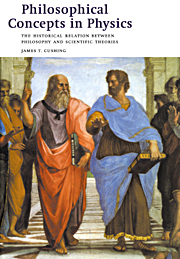 Philosophical Concepts in Physics
Philosophical Concepts in Physics Book contents
- Frontmatter
- Contents
- Preface
- Copyright acknowledgments
- PART I The scientific enterprise
- PART II Ancient and modern models of the universe
- PART III The Newtonian universe
- PART IV A perspective
- PART V Mechanical versus electrodynamical world views
- PART VI The theory of relativity
- PART VII The quantum world and the completeness of quantum mechanics
- 19 The road to quantum mechanics
- 20 Copenhagen quantum mechanics
- 21 Is quantum mechanics complete?
- PART VIII Some philosophical lessons from quantum mechanics
- PART IX A retrospective
- Notes
- General references
- Bibliography
- Author index
- Subject index
19 - The road to quantum mechanics
Published online by Cambridge University Press: 05 June 2012
- Frontmatter
- Contents
- Preface
- Copyright acknowledgments
- PART I The scientific enterprise
- PART II Ancient and modern models of the universe
- PART III The Newtonian universe
- PART IV A perspective
- PART V Mechanical versus electrodynamical world views
- PART VI The theory of relativity
- PART VII The quantum world and the completeness of quantum mechanics
- 19 The road to quantum mechanics
- 20 Copenhagen quantum mechanics
- 21 Is quantum mechanics complete?
- PART VIII Some philosophical lessons from quantum mechanics
- PART IX A retrospective
- Notes
- General references
- Bibliography
- Author index
- Subject index
Summary
The theory of relativity is essentially the culmination of classical physics. Although revisions in our concepts of space and time are necessitated by both the special and general theories of relativity, the notion of causality, in which a cause precedes its effect, remains intact in the relativistic formulations of electrodynamics and mechanics and of gravitation. An upper limit is set on the speed of bodies, and of the propagation of energy, and physical quantities are often defined operationally, but once we adjust ourselves to these new rules, our representations of physical processes proceed pretty much as they did in classical physics. On the other hand, quantum theory seems to require a much more profound philosophical revision of our thought patterns. Even the viability of the usual meaning of a causal connection between one event and another is there called into question.
SOME HISTORICAL BACKGROUND
We begin with a brief and highly selective review of the experimental and theoretical problems that formed the conceptual backdrop to the emergence of quantum theory. We focus attention first on an important phenomenon – blackbody radiation – that was instrumental for the formulation of quantum mechanics. A blackbody is defined as a surface that absorbs all of the electromagnetic radiation that falls onto it. It is picturesquely so named since any light incident on such a body would be absorbed, making it appear black (at least at typical temperatures in our environment). A blackbody also emits radiation.
- Type
- Chapter
- Information
- Philosophical Concepts in PhysicsThe Historical Relation between Philosophy and Scientific Theories, pp. 273 - 289Publisher: Cambridge University PressPrint publication year: 1998
